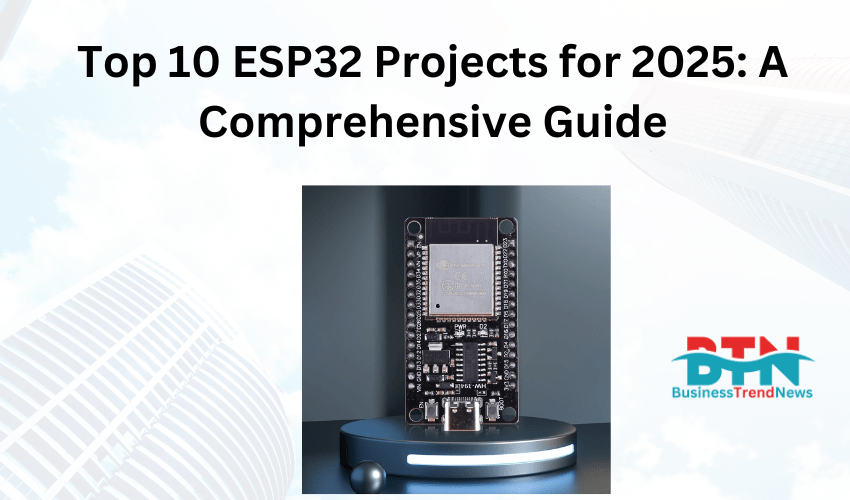![]()
Top 10 ESP32 Projects for 2025: A Comprehensive Guide
The ESP32 is a popular microcontroller with built-in Wi-Fi and Bluetooth, making it a favorite for hobbyists, engineers, and makers who want to create IoT (Internet of Things) projects. It combines versatility, low cost, and powerful capabilities. Whether you’re a beginner or an experienced developer, the following list of ESP32 projects will inspire you to make the most of this powerful microcontroller.
1. Smart Home Automation System
Overview: Automate your home by controlling lights, fans, and other appliances remotely using the ESP32. You can use smartphone apps or voice assistants like Google Assistant or Amazon Alexa to control various home devices.
Key Features:
- Control devices using Wi-Fi.
- Integrate with voice assistants (using IFTTT or MQTT).
- Schedule automation tasks (e.g., turn off lights at night).
How It Works:
- Use the ESP32 to connect relays to appliances.
- Connect the system to a Wi-Fi network and use the Blynk or Home Assistant app for remote control.
Benefits:
- Inexpensive and scalable home automation.
- Easy to set up and customize for different devices.
2. ESP32 Web Server
Overview: This project involves setting up a web server using the ESP32 that allows users to interact with the microcontroller through a web interface. You can control LED lights, read sensor data, and monitor the state of various inputs.
Key Features:
- Host a web interface on the ESP32.
- Control GPIO pins through the web page.
- Monitor real-time data from sensors.
How It Works:
- The ESP32 runs as a web server that serves HTML pages.
- Users can control outputs and read inputs by sending commands from the browser.
Benefits:
- Great for home automation and monitoring systems.
- Easy to expand by adding more sensors and actuators.
3. Wi-Fi Security Camera
Overview: Create a simple security camera using the ESP32-CAM module. This project can stream live video over Wi-Fi and store captured images on an SD card.
Key Features:
- Live video streaming over the internet or local network.
- Motion detection with image capture.
- Store captured images on an SD card.
How It Works:
- The ESP32-CAM captures video through its camera module.
- The video is streamed using a web server or sent to cloud storage via FTP or MQTT.
Benefits:
- Low-cost DIY security system.
- Can be integrated with home automation systems.
4. Smart Plant Monitoring System
Overview: Monitor the health of your plants using sensors connected to the ESP32. This project measures soil moisture, light intensity, and temperature to ensure your plants are thriving.
Key Features:
- Real-time monitoring of soil moisture, temperature, and light.
- Automated watering system using a water pump.
- Notifications via smartphone or web dashboard.
How It Works:
- The ESP32 reads data from sensors and triggers a water pump if moisture levels are too low.
- Use an IoT dashboard (e.g., Thingspeak or Blynk) to visualize data.
Benefits:
- Saves time and effort in maintaining plants.
- Helps ensure optimal growth conditions.
5. ESP32 Bluetooth Low Energy (BLE) Beacon
Overview: The ESP32 can be used as a BLE beacon to send out information to nearby Bluetooth-enabled devices like smartphones. This is useful for location-based services or data broadcasting.
Key Features:
- Sends Bluetooth advertisements at regular intervals.
- Can be used for location tracking or information broadcast.
- Low power consumption in BLE mode.
How It Works:
- The ESP32 acts as a BLE peripheral device, sending advertising packets.
- A smartphone app can pick up these packets and trigger certain actions (e.g., notifications, location tracking).
Benefits:
- Ideal for proximity marketing, asset tracking, and navigation.
- Easy to set up with various libraries and apps.
6. IoT Weather Station
Overview: Build an IoT-based weather station that measures temperature, humidity, and atmospheric pressure using the ESP32 and connected sensors. The data can be displayed on a web dashboard or sent to cloud services for analysis.
Key Features:
- Real-time weather data monitoring.
- Upload data to cloud platforms like Thingspeak or Google Sheets.
- Display data on an OLED screen or web interface.
How It Works:
- Use sensors like DHT22 (temperature and humidity) and BMP280 (pressure) to collect data.
- The ESP32 sends this data to the cloud for visualization and analysis.
Benefits:
- Learn about weather data collection and IoT platforms.
- Can be extended to include air quality or UV index measurements.
7. Voice-Controlled Smart Mirror
Overview: Create a smart mirror using an ESP32, a screen, and a two-way mirror. The ESP32 can act as the main controller for the smart features, including displaying time, weather, calendar events, and even controlling lights via voice commands.
Key Features:
- Voice commands via Google Assistant or Alexa.
- Display useful information like weather, calendar, and news.
- Can control smart home devices (lights, music, etc.).
How It Works:
- The ESP32 connects to a display and microphone.
- Voice commands are processed via cloud services like IFTTT or Google Assistant.
Benefits:
- A futuristic home accessory that combines aesthetics with smart functionality.
- Can be expanded with more widgets and services.
8. ESP32-Powered Smart Door Lock
Overview: Enhance the security of your home with a smart door lock powered by the ESP32. This project allows you to control a door lock via a smartphone app, RFID, or even biometric fingerprint sensors.
Key Features:
- Control the lock via Wi-Fi or Bluetooth.
- Support for RFID cards or biometric sensors.
- Send notifications when the door is unlocked or locked.
How It Works:
- The ESP32 connects to an electronic lock and either opens or closes the lock based on commands from an app.
- You can integrate RFID or fingerprint sensors for secure access.
Benefits:
- Affordable smart security solution.
- Can be monitored remotely and provide activity logs.
9. Air Quality Monitoring System
Overview: Measure the air quality around you with an ESP32-based system. Using air quality sensors, you can detect harmful gases like CO2 and VOCs and keep track of pollution levels.
Key Features:
- Real-time monitoring of air quality (CO2, PM2.5, and VOCs).
- Display data on a web dashboard or send notifications if levels are unsafe.
- Upload data to cloud platforms for long-term tracking.
How It Works:
- The ESP32 reads data from air quality sensors like the MQ135 or CCS811.
- Data is processed and displayed on an OLED screen or web interface.
Benefits:
- Helps ensure a safe and healthy environment.
- Great for environmental monitoring and awareness.
10. ESP32-Based GPS Tracker
Overview: Track vehicles, pets, or personal belongings with an ESP32-based GPS tracker. The project uses GPS modules to get location data and transmits the information over Wi-Fi or GSM networks.
Key Features:
- Real-time GPS tracking with location updates.
- Transmit data via Wi-Fi or GSM.
- View location on Google Maps or similar platforms.
How It Works:
- The ESP32 reads data from a GPS module (like the NEO-6M) and transmits it to a cloud service for tracking.
- You can use a web interface or mobile app to see the real-time location.
Benefits:
- Great for asset tracking, fleet management, or personal use.
- Can be enhanced with geofencing and alerts.
Conclusion
The ESP32’s versatility makes it an excellent platform for a wide range of projects. From smart home automation and security systems to IoT applications and personal gadgets, the possibilities are nearly endless. Each of these projects leverages the ESP32’s built-in Wi-Fi, Bluetooth, and processing power to create useful and engaging devices. Whether you’re looking to dive into the world of IoT or create something innovative, the ESP32 offers the flexibility and power to bring your ideas to life.
With open-source libraries and a large community of developers, you’ll find plenty of resources and inspiration to help you along the way.



